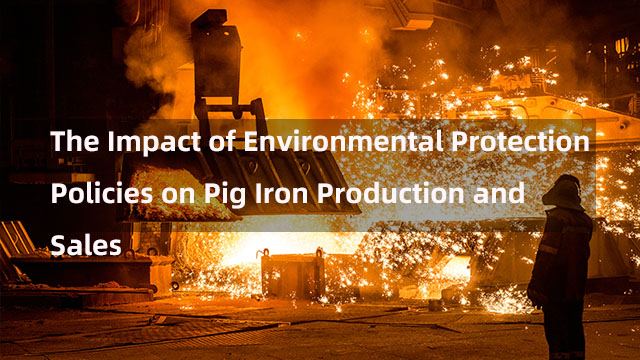The Impact of Environmental Protection Policies on Pig Iron Production and Sales
2025-02-10 09:38:54 hits:0
In the context of the global strong advocacy for sustainable development today, environmental protection policies play an increasingly crucial role in various industries, and the pig iron production and sales sector is no exception. A series of strict environmental protection policies have been successively introduced, having a profound impact on the production mode and sales pattern of the pig iron industry.

I. Environmental Protection Policies Raise the Threshold for Production Access
(1) Exhaust Gas Emission Control
From the perspective of production, environmental protection policies have greatly raised the threshold for pig iron production access. In terms of exhaust gas emissions, policies require pig iron production enterprises to install highly efficient desulfurization, denitrification, and dust - removal equipment to reduce the emissions of pollutants such as sulfur dioxide, nitrogen oxides, and dust. Take a medium - sized pig iron production enterprise as an example. Before the implementation of environmental protection policies, its annual sulfur dioxide emissions reached as high as 500 tons. To meet the environmental protection standards, the enterprise invested 5 million yuan to purchase advanced electrostatic dust - removal equipment and flue gas desulfurization devices. After the equipment was put into use, sulfur dioxide emissions were reduced to less than 100 tons, and nitrogen oxide and dust emissions also decreased significantly. However, this has significantly increased the enterprise's upfront equipment investment costs. According to statistics, within one year after the implementation of the policies, due to the difficulty in bearing the high - cost procurement and operation of environmental protection equipment, nearly 30% of small - sized pig iron production enterprises reduced production, and 10% were forced to suspend production.
(2) Improvement of Wastewater Treatment Standards
In terms of wastewater treatment, environmental protection policies also put forward strict standards. The wastewater containing heavy metals and harmful substances generated in the pig iron production process must be professionally treated to meet the discharge standards before being discharged. A large - scale steel enterprise used to discharge about 500,000 tons of untreated wastewater directly every year. To meet the environmental protection requirements, the enterprise invested 8 million yuan to establish a complete wastewater treatment system, and carried out multiple processes such as sedimentation, filtration, and purification on the wastewater. At the same time, the enterprise increased the reuse rate of water resources from the original 30% to 70% by building a circulating water system, and reduced the total annual wastewater discharge to 200,000 tons. However, the enterprise has made huge continuous investments in technological research and development and equipment transformation during this process.
II. Environmental Protection Policies Reshape the Sales Pattern
(1) Growth in the Demand for Green Products
Environmental protection policies also have a significant impact on the sales of pig iron. On the one hand, with the deep - rooted environmental protection concept, the demand of downstream customers for green and environmentally friendly products is gradually increasing. Those enterprises that can strictly abide by environmental protection policies and produce low - pollution and high - quality pig iron products are more favored in the market, and their sales channels are more unobstructed. Take the construction industry as an example. According to relevant surveys, after the promotion of the green building concept, about 80% of construction enterprises tend to choose products that meet environmental protection standards when purchasing pig iron for construction steel production to meet the requirements of green building certification. This has led to a growth of about 30% in the sales volume of pig iron products that meet environmental protection standards in the past five years.
(2) Restrictions on the Transportation Link
On the other hand, the implementation of environmental protection policies has also restricted the transportation link of pig iron. In some areas, in order to reduce dust and exhaust emissions during transportation, strict regulations have been made on the emission standards and loading requirements of transportation vehicles. For example, in a certain area, vehicles transporting pig iron must meet the National VI emission standards, and the loading must adopt closed - type transportation. This has increased the transportation cost of pig iron by about 20 yuan per ton in this area, directly affecting the final sales price of the product. At the same time, due to non - compliance with environmental protection requirements, about 20% of transportation enterprises in this area are restricted from participating in the pig iron transportation business, resulting in a reduction in the sales scope of some pig iron production enterprises, a decrease in distribution efficiency, and an extension of the product inventory backlog time.
III. Embrace Challenges and Seize Opportunities
The implementation of environmental protection policies brings both challenges and opportunities to pig iron production and sales. For pig iron production enterprises, only by actively responding to environmental protection policies, increasing investment in environmental protection, and promoting technological innovation can they achieve sustainable development under increasingly strict environmental supervision and gain an advantage in market competition.

 en
en  fra
fra  de
de  ru
ru  gle
gle  th
th  ara
ara  it
it  jp
jp  kor
kor  zh
zh 


